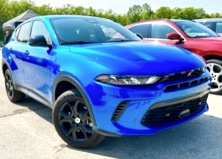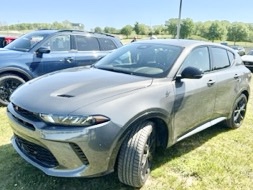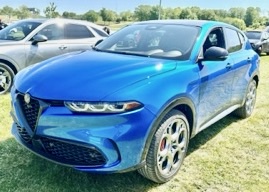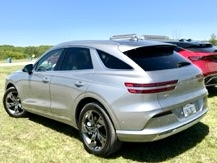MAMA Spring Rally dazzling dose of future
By John Gilbert
ELKHART LAKE, WIS. — Familiarity with the past blended with future surrealism inside my helmet when I drove my first lap around the 4-mile Road America race course to open the 2023 Midwest Auto Media Association Spring Rally. The familiarity came because of previous driving on that track, and my first lap was behind the wheel of a Dodge Challenger Last Call Black Ghost.
Time is running out on the traditional muscle cars with roaring engines, and the most spectacular of all the retro cars is the Challenger, which never lost its charisma as a hot-rod coupe since it was raced by Dan Gurney in the 1970 Trans-Am road-race series, which competed on this very same track. The new one is a special-order, limited-production model that looks and behaves in an eerily nostalgic manner, with an overpowering supercharged 6.2-liter V8 and the accompanying roar as it sends 807 horsepower to the rear wheels. Only this one — officially named “SRT Hellcat Redeye Widebody Black Ghost” — is smooth and sophisticated in its handling as you accelerate, decelerate, cut hard into the late-apex corners of the track’s 14 turns — plus a series of cone-lined chicanes. Those cones are to prevent loonies from overdoing it, although they also provide the added familiarity of any highway construction season slalom.
The surreal part of those two midweek days on the legendary track is that the MAMA Spring Rally was also my official emergence from what seems like a time capsule. It was a year ago at the paddock of this track that I went from knowing I’d had a 100-percent clean bill of health less than a year earlier to suffering shortness of breath that was severe enough to toss me into an ambulance and whisk me to the SSM Health Center in nearby Fond du Lac. Doctors there found a blocked artery and two other partially blocked arteries, and inserted stents in those three arteries.
Incredibly, and maybe miraculously, my heart stopped three times while the surgery was being performed, and those outstanding doctors brought me back to life all three times. When I came to, my wife, Joan, and younger son, Jeff, had joined older son, Jack, at my bedside. I thought it must have been the next morning, but it actually was seven days later, on June 1.
After three weeks in that wonderful hospital, it has taken a full year of slow but steady recovery, which meant no trips to new car introductions or auto shows. Doctors continue to use the “miracle” word to describe my regaining of health and strength to reach something approaching normal. Son Jack accompanied me again this year, and supplied most of the photos of the array of new cars, which we drove. We started by driving seven hours from Duluth to Elkhart Lake — which I drove entirely as another personal test.
The highlights of the test drives included that Challenger and a Mustang Darkhorse, but fed the time-capsule motif by underlining the transformation we’re all facing to electrified powerplants. Yes, I drove a Tesla Model Y, and I will be dealing with the new cars in greater detail as I get to road-test them more extensively. For now, here are capsule looks at my favorites:
DODGE HORNET — This all-new compact vehicle is between tall sedan and compact SUV, and both the 2023 GT, with a 2.0-liter turbocharged 4-cylinder, and nearly identical 2024 R/T,
with amazing power capabilities out of a 1.3-liter 4-cylinder and battery-pack hybrid, have all-wheel drive. The R/T is two seconds quicker 0-60, and the GT pulls away at top speed, but the R/T gets much better fuel economy, with judicious use of the electric-drive feature. With its added technology, the R/T is also more expensive, rising from $40,000 to $50,000 when loaded, while the GT, which lacks the R/T’s paddle shifters, ranges from $35,000 to $41,000. We haven’t heard much about this first major project from newly renamed Stellanis, but we will.
ALFA ROMEO TONALE PHEV — With strong family resemblance to the Giulia sedan and Stelvio
SUV, the Tonale is right between the two in size, and caught me by complete surprise when I learned it was a full plug-in hybrid that can reach 75 miles per gallon, with superb performance and Alfa’s traditional charisma, and riding the crest of a wave of focus by Stellanis on quality control and customer satisfaction for trouble-free ownership — as evidenced by the latest JDPower customer votes and comments. It gets 285 horsepower and 347 foot-pounds of torque from its 1.3-liter gas engine and potent battery pack, balanced for nearly perfect 50-50 weight distribution, and a high-tech mode-selection set of switches and paddle shifters with all-wheel drive. You can lock it into pure-electric potency and drive to work and back all week without buying any gasoline. Price is $47,000 or $57,000 if equipped the way the test car was.
HYUNDAI ELANTRA “N” — The popular compact reworked into a performance model was one of the most impressive sporty cars at the track, with exceptional seats, power, sound, quick-handling, and acceleration and braking. If you want a fun family car, that is eager to be taken to “track days,” the Elantra N is a $35,000 prize.
BMW M2 COUPE — One particular know-it-all type of journalist held court next to the BMW area of the paddock and raved about how BMW had “lost it” from a design standpoint and are no long desirable. That is a common trend among the auto media these days, because of over-dramatized grille design of various models. I couldn’t resist suggesting the other side of the coin is that all the great BMWs from the past 30 years share a similarity that makes them all look like the latest model; while the new-grille design is immediately distinguishable as “the new one.” The always-popular M3 has grown too big, but also big enough to room for the more compact M2 to become its replacement for serious drivers on a budget. With an inline 6-cylinder, the M2 is swift, precise, extremely comfortable for seat support, and comes in either stick or automatic.
More than 100 MAMA members showed up for the Rally, and we voted on best vehicles in various categories, such as:
Favorite family vehicle: Honda CR-V Hybrid got my vote, edging the Kia Telluride X-Pro;
Favorite luxury vehicle: Genesis had a hat trick of winners, with the Genesis GV70 Electrified SUV, the G80 Electrified sedan, and the splendid G90 sedan, which won Motor Trend’s Car of the Year award, all topping the Mercedes Benz AMG GLE 53 and the Lexus RX.
Favorite Off-Road vehicle: Ford F150 Raptor R, nipping the Jeep Wrangler 4Xe 20th Anniversary.
Favorite Pickup: Ford Maverick Tremor, with close competition from Toyota’s new twin-turbo Tundra, and the redone Chevy Colorado.
Favorite Performance vehicle: I had to give it to the Hornet R/T for its high-tech functionality, in the tightest competition of any category, with the BMW M2, Kia EV6 GT, Lexus RC-F, and Mercedes AMG GT 63, outrunning the rumbling Challenger.
Favorite EV or Plug-In vehicle: Alfa Romeo Tonale PHEV narrowly ahead of the Genesis GV70 and Prius Prime.
Favorite Affordable vehicle: Subaru Impreza RS in a narrow decision over the Hornet GT and the reborn Acura Integra.
From those selections, I found it interesting that Stellanis caught me by surprise with the Alfa Romeo Tonale being aimed at changing the traditional reputation of Alfas for being fun, charming, but unreliable to being fun, charming, and reliable enough to outpoint Mercedes, BMW and Audi in the JDPowers surveys for initial quality and reliability. The Tonale, I’m told, is being focused on the U.S. market. To which I say, “Bring it on!”
Stellanis also earns strong points in that the Hornet is a candidate for both performance and affordable vehicles and the Alfa is a winner among electrified answers that move into the future without going all-electric.
Also, while Honda is altering its effort for hybrids in Accord, Civic and CR-V, the South Korean partners of Hyundai and Kia continue their dazzling array of electrified cars, with Hyundai’s exotic new Ioniq6 and the still flashy Ioniq5, plus those Genesis upscale models, and Kia’s EV6 and the EV6 GT. And there’s that fall-back choice of the Elantra N for traditional but highly-efficient fun.
It’s about time I came out of my time capsule to try to catch up with such an outstanding array of new and transitional vehicles.






 John Gilbert is a lifetime Minnesotan and career journalist, specializing in cars and sports during and since spending 30 years at the Minneapolis Tribune, now the Star Tribune. More recently, he has continued translating the high-tech world of autos and sharing his passionate insights as a freelance writer/photographer/broadcaster. A member of the prestigious North American Car and Truck of the Year jury since 1993. John can be heard Monday-Friday from 9-11am on 610 KDAL(www.kdal610.com) on the "John Gilbert Show," and writes a column in the Duluth Reader.
John Gilbert is a lifetime Minnesotan and career journalist, specializing in cars and sports during and since spending 30 years at the Minneapolis Tribune, now the Star Tribune. More recently, he has continued translating the high-tech world of autos and sharing his passionate insights as a freelance writer/photographer/broadcaster. A member of the prestigious North American Car and Truck of the Year jury since 1993. John can be heard Monday-Friday from 9-11am on 610 KDAL(www.kdal610.com) on the "John Gilbert Show," and writes a column in the Duluth Reader.